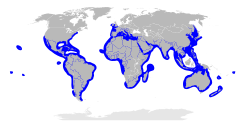| Sphyrna Temporal range: | |
|---|---|
 | |
| Great hammerhead (S. mokarran) | |
| Scientific classification | |
| Kingdom: | Animalia |
| Phylum: | Chordata |
| Class: | Chondrichthyes |
| Subclass: | Elasmobranchii |
| Division: | Selachii |
| Order: | Carcharhiniformes |
| Family: | Sphyrnidae |
| Genus: | Sphyrna Rafinesque, 1810 |
| Type species | |
| Squalus zygaena | |
 | |
| Synonyms | |
| |
Sphyrna is a genus of hammerhead sharks with a cosmopolitan distribution in the world's oceans. Members of Sphyrna have a tendency to inhabit coastal waters along the intertidal zone rather than the open ocean, as their prey such as invertebrates, fish, rays, small crustaceans, and other benthic organisms hide in the sands and sediment along these zones. Members of Sphyrna are also known by synonyms such as Zygaena, Cestracion, and Sphyrichthys. The earliest species described of this genus was Sphyrna zygaena by Carl Linnaeus in 1758, while the latest described member, Sphyrna alleni , was described in 2024.
The genus name comes from the Greek word σφῦραsphyra "hammer", it is also where the family name Sphyrnidae comes from. [1]
The earliest known fossil species of Sphyrna is † Sphyrna guinoti from the mid-late Eocene of Tunisia and Egypt. [2]
